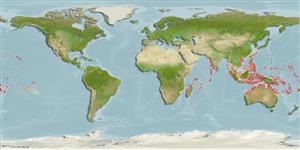Common names from other countries
Environment: milieu / climate zone / depth range / distribution range
Écologie
marin récifal; profondeur 1 - 15 m (Ref. 86942). Tropical; 32°N - 24°S
Indo-Pacific: East Africa to the Tuamoto Islands, north to southern Japan and the Ogasawara Islands, south to the Great Barrier Reef.
Taille / Poids / Âge
Maturity: Lm ? range ? - ? cm
Max length : 5.0 cm TL mâle / non sexé; (Ref. 2334)
Épines dorsales (Total) : 7 - 8; Rayons mous dorsaux (Total) : 12 - 13; Épines anales: 2; Rayons mous anaux: 11 - 12. Uniformly dark species that has smaller, but longer tubercles than C. maculatus and lacks a notch in the dorsal fin.
Facultative air-breathing (Ref. 126274); Found among branches of Stylophora mordax and certain Acropora corals (Ref. 9710). It never ventures outside the confines of the coral head where it swims between the branches foraging for other coral-dwelling types (Ref. 275). Anterolateral glandular groove with venom gland; at least in dorsal-fin spines (Ref. 57406).
Life cycle and mating behavior
Maturities | Reproduction | Spawnings | Egg(s) | Fecundities | Larves
Paxton, J.R., D.F. Hoese, G.R. Allen and J.E. Hanley, 1989. Pisces. Petromyzontidae to Carangidae. Zoological Catalogue of Australia, Vol. 7. Australian Government Publishing Service, Canberra, 665 p. (Ref. 7300)
Statut dans la liste rouge de l'IUCN (Ref. 130435)
CITES (Ref. 128078)
Not Evaluated
Utilisations par l'homme
Outils
Articles particuliers
Télécharger en XML
Sources Internet
Estimates based on models
Preferred temperature (Ref.
115969): 25.4 - 29.3, mean 28.3 (based on 2461 cells).
Phylogenetic diversity index (Ref.
82804): PD
50 = 0.5625 [Uniqueness, from 0.5 = low to 2.0 = high].
Bayesian length-weight: a=0.01995 (0.00906 - 0.04395), b=3.01 (2.83 - 3.19), in cm Total Length, based on all LWR estimates for this body shape (Ref.
93245).
Niveau trophique (Ref.
69278): 3.6 ±0.59 se; based on food items.
Fishing Vulnerability (Ref.
59153): Low vulnerability (10 of 100).
